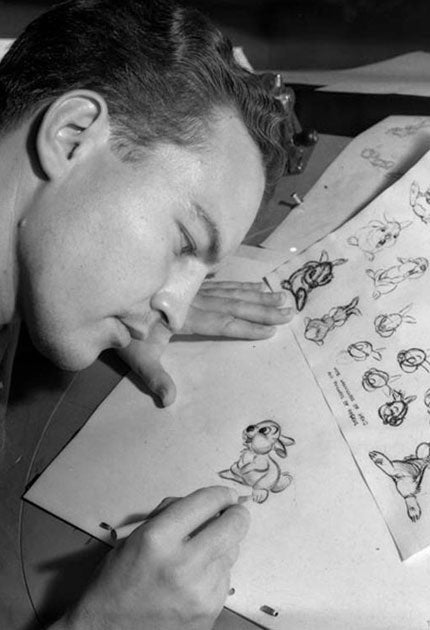Bill Justice: Animator and Disney mainstay across five decades

Bill Justice, Disney animator and imagineer, worked on such classics as Fantasia, Alice in Wonderland and Peter Pan. In a career spanning five decades, Justice worked on 57 shorts and 19 feature films. Among the memorable characters he animated were the precocious Thumper in Bambi and the mischievous Chip'n'Dale. He also programmed Audio-Animatronics figures for the theme parks.
Once, when asked if he ever got bored of drawing Mickey Mouse, Justice replied, "Have you seen me draw Mickey upside down?" He then did so – effortlessly.
Born in Dayton, Ohio in 1914, Justice grew up in Indianapolis and attended the John Herron Art Institute, where he studied to be a portrait artist. Upon graduating in 1935, he moved to California and two years later responded to a Disney recruitment advertisement. He began work as an "in-betweener" on Snow White and the Seven Dwarfs (1937), which was near completion, providing the intermediary drawings between the key images produced by the studio's lead animators. However, a quick learner, he was rapidly promoted to full animator, contributing scenes to Pinocchio and the Pastoral Symphony segment of Fantasia (both 1940).
Snow White was a huge hit and as a thank-you for two years' work, Walt and Roy Disney laid on a lavish party that was later dubbed the "Snow White Orgy". Justice recalled: "There were naked swim parties, people got drunk, and they were often surprised at what room they were in and who they were sleeping next to when they awoke the next morning."
On Bambi (1942), Justice developed the exuberant rabbit Thumper with particular attention to the winter sequence, in which he joins Bambi on the ice. He was "cast" like an actor because of his skills with particular character types, in his case "cute". To make the action as realistic as possible, Justice and his fellow animators attended lectures given by animal experts, visited the Los Angeles Zoo and viewed specially commissioned nature footage shot in the forests of Maine. Although production progressed slowly, Disney was delighted and declared, "Fellas, this stuff is pure gold."
During the war, Justice was involved with such films as Saludos Amigos (1942), Victory Through Air Power (1943) and The Three Caballeros (1944). After the war he was heavily involved in the studio's revival, working on classics such as Alice in Wonderland (1951) and Peter Pan (1953), but was perhaps best known for his animation of the two mischievous chipmunks Chip'n'Dale, who tormented Donald Duck over 24 cartoon episodes.
With the proliferation of television during the early 1950s, Disney decided to make the transition, too. Justice directed the animated Mickey Mouse March opening for The Mickey Mouse Club that premiered in October 1955. The film critic and historian Leonard Maltin said, "If he'd done nothing else but direct that unforgettable Mickey Mouse Club opening, he'd have a place in the hearts of baby-boomer Disney fans everywhere."
In the 1950s and early '60s, Justice directed three Oscar-nominated Disney animated shorts, The Truth About Mother Goose (1957), Noah's Ark (1959) and A Symposium on Popular Songs (1962). Teamed with Disney colleagues Xavier Atencio and T Hee, Justice also did stop-motion animation in live-action Disney features such as The Parent Trap (1961), Mary Poppins (1964) and Babes in Toyland (1961).
Recognising Justice's immense talent and versatility, Walt seconded him and a few colleagues to WED Enterprises, where they worked as "Imagineers". Again, he brought the same sense of inventiveness to this field as he did to animation. The brief was to help in the creation of mystical environments and attractions for the Disneyland and Disney World theme parks. His animation skills were applied to computer-programmed Audio-Animatronics figures in attractions such as the Haunted Mansion, Pirates of the Caribbean, Mission to Mars and Great Moments with Mr Lincoln. Justice recalled, "You have to analyse every movement you animate. You're the actor. You have to put yourself into it and get a feel for what you are doing." He is also said to have "masterminded" the Mickey Mouse Revue featured at Walt Disney World and Tokyo Disneyland.
Justice also designed the floats and costumes for the first Disneyland Christmas Parade and created sketches for the first Main Street Electrical Parade. After retirement in 1979 Justice chronicled his 42 years at Disney in Justice for Disney. He was often found at Disney conventions, on cruise ship excursions, and at other events where he wowed the audience with his art works, often drawing Disney characters on hotel linen napkins and paper plates and then tossing them like frisbees into the crowd.
William Justice, animator and imagineer: born 9 February 1914, Dayton, Ohio; married Kim (one daughter); died Santa Monica, California 10 February 2011.
Subscribe to Independent Premium to bookmark this article
Want to bookmark your favourite articles and stories to read or reference later? Start your Independent Premium subscription today.

Join our commenting forum
Join thought-provoking conversations, follow other Independent readers and see their replies